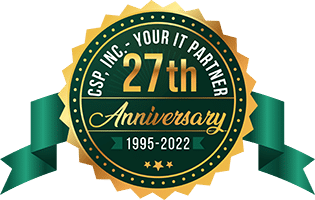1310 Nowell Road
Raleigh, NC 27607
1310 Nowell Road
Raleigh, NC 27607
Existing CSP Client: (919) 424-2060
SALES: (919) 420-3231

It’s no secret that technology has completely transformed the way we do business. From cloud computing to mobile devices, there are countless tools and resources available to help companies operate more efficiently and effectively.
However, these benefits also come with risks, particularly when it comes to unapproved technology being used at your company. This is known as “shadow IT,” and it can pose significant threats to the security and stability of a business.
In this guide, we will discuss what shadow IT is, its potential risks, and, most importantly, how to protect your business. By being proactive and taking the necessary precautions, you can prevent shadow IT from causing harm to your company.
Shadow IT refers to any technology or software that is used within a company without the approval or knowledge of the IT department. This can include everything from personal smartphones and laptops to cloud services and productivity apps.
Essentially, anything that is not officially sanctioned or supported by the company’s IT team falls under the umbrella of shadow IT. And, with the rise of remote work and the increasing accessibility of technology, it’s only becoming more prevalent in the workplace. In fact, a study by Gartner found that 41% of employees reported using unauthorized tech for work purposes.
So why do employees turn to shadow IT in the first place? It’s not usually out of malicious intent; instead, it’s often due to:
While it may seem harmless on the surface, shadow IT can bring many risks and challenges to a business. These include:
Using unapproved tools can expose a company’s sensitive data to security breaches and cyberattacks. Shadow IT often lacks the necessary security protocols and updates, leaving systems vulnerable to hackers.
With people using different tools and devices, it becomes challenging for the IT team to track and manage all technology in use. This lack of control can make enforcing compliance with regulations or company policies difficult.
When employees use their own tools and devices, relevant data may not be shared with the rest of the team or backed up on company servers. This can lead to data silos, making it difficult for teams to collaborate and causing loss of important information.
Tracking and addressing unauthorized technology retroactively can strain IT resources and increase costs. Fixing issues caused by shadow IT often takes time and effort that could have been avoided with proper oversight.
Addressing shadow IT requires a proactive approach. Here’s how you can safeguard your business while empowering employees with the tools they need:
Create a culture where employees feel comfortable discussing their technology needs. By understanding their challenges, companies can recommend suitable tools and eliminate the need for shadow IT.
Establish and communicate clear guidelines on what technology and tools are approved for use. Include explanations of why these policies are essential to the company’s security and compliance.
Ensure that approved tools and systems are intuitive, efficient, and capable of meeting employee needs. Conduct regular surveys or feedback sessions to assess satisfaction with the current tech stack.
Train employees on the risks of shadow IT and the importance of using approved tools. Provide practical examples of how shadow IT can lead to security breaches or compliance issues.
Deploy monitoring tools to track the use of unapproved apps and devices. While this shouldn’t replace trust, it can provide insights into potential risks and help you address them quickly.
Shadow IT doesn’t have to be a looming threat to your business. By understanding why it happens and taking proactive measures to address it, you can mitigate risks while fostering a secure, productive work environment.
Remember, the goal isn’t to stifle innovation but to strike a balance between empowering employees and maintaining control over your company’s technology landscape. So, take steps today to protect your business from the hidden risks of shadow IT.

Always at your service to provide the highest level of quality support to our customers.

Anthony Firth Client Engineer

“I’m passionate about building and fostering relationships, and finding solutions for success.”

Michael Koenig Client Account Manager

“I help clients stabilize and grow their IT infrastructure so they can focus on growing their core business.”

Josh Wilshire Systems Engineer Team Lead

“I strive to provide the highest level of quality service to our customers.”

Tommy Williams Sr. Hardware Engineer

“I’m driven by the steadfast belief that technology must serve as a business enabler. This mantra has driven 21
Years of successful partnerships.”

Stephen Riddick VP Sales & Marketing

“CSP doesn’t succeed unless your company succeeds.”

Stephen Allen Inventory Manager

“Through my intuition and genuine concern to help others I have built long-lasting relationships with our customers, co-workers and business partners.”

Scott Forbes VP Support Services

“Every day, I work with clients to help plan the future of their businesses.”

Michael Bowman vCIO

“Your IT problems become our IT solutions.”

Mark McLemore Project Engineer

“Managing internal and external operations to ensure that CSP provides quality and reliable customer service .”

Margie Figueroa Business Manager

“Providing quality internal and externals financial support to our customers and accounting support to CSP.”

Katie Steiglitz Accounting Administrator

“Some call me the CEO. I call myself the Cheerleader for an awesome team!”

William B. Riddick Founder & CEO

“CSP is here to assist you with your IT needs.”

Beth Wylie Inside Sales Manager




On What Questions You Need To Ask Before Signing Any Agreement.
"*" indicates required fields

Raleigh IT Support Company and IT Services Provider | CSP Inc.
1310 Nowell Rd,
Raleigh, NC 27607
Existing CSP Client: (919) 424-2060
SALES: (919) 420-3231
Receive email updates and informative marketing materials by subscribing to our newsletter.
"*" indicates required fields